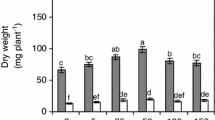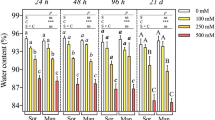Abstract
The use of in vitro shoot cultures to evaluate osmotic and salt tolerance and the effects of salt and mannitol in the medium on proline and sugar accumulation were investigated in two poplar species, P. euphratica and P. alba cv. Pyramidalis × P. tomentosa. Shoot length, leaf number, whole plant dry weight, and the accumulation of proline and total soluble sugars in leaves were quantified after 2 weeks. All P. euphratica plantlets survived at all levels of mannitol and NaCl, while the mortality of P. alba cv. Pyramidalis × P. tomentosa increased both at the mannitol and the NaCl treatments. A significant increase in proline accumulation was observed in both young and mature P. euphratica leaves at 200 mM mannitol and above, and at 150 mM NaCl and above. The total soluble sugar content increased in young P. euphratica leaves at 250 mM NaCl; however, it decreased in the mature leaves. Similar increases of the total soluble sugar content were not seen in P. alba cv. Pyramidalis × P. tomentosa plants in response to either mannitol or NaCl treatment. Our results suggest that accumulated proline and sugars promote osmotic and salt tolerance. The effects of accumulated proline and total soluble sugars on leaves are discussed in relation to growth and osmotic adjustment.
Similar content being viewed by others
References
Ackerson RC (1981) Osmoregulation in cotton in response to water stress. II. Leaf carbohydrate status in relation to osmotic adjustment. Plant Physiol. 67: 489–493
Bates LS, Waldren RP & Teare ID (1973) Rapid determination of free proline for water stress studies. Plant and Soil 39: 205–207
Boyer JS (1982) Plant productivity and environment. Science 218: 443–448
Browicz K (1977) Chorology of Populus euphratica Olivier. Arboretum Kornickie 22: 5–27
Cano EA, Perez-Alfocea F, Moreno V, Caro M & Bolarin MC (1998) Evaluation of salt tolerance in cultivated and wild tomato species through in vitro shoot apex culture. Plant Cell Tiss. Org. Cult. 53: 19–26
Gebre GM, Brandle JR & Kuhns MR (1997) Influence of rewatering and time of sampling on solute accumulation of two Populus deltoides clones. Tree Physiol. 17: 341–346
Hasegawa PM, Bressan RA & Handa AK (1986) Cellular mechanisms of salinity tolerance. Hortscience 26: 1317–1324
Hasegawa PM, Bressan RA, Zhu J-K & Bohnart HJ (2000) Plant cellular and molecular responses to high salinity. Ann. Rev. Plant Physiol. Plant Mol. Biol. 51: 463–499
Hou HU (1985) Floodplain meadows, gallery forests, and oases. In: Goodin JR & Northington DK (eds) Plant Resource of Arid and Semi Arid Lands – A Global Perspective (pp 246–249). Academic Press, Orlando
Irigoyen JJ, Emerich DW & Sanchez-Diaz M (1992) Water stress induced changes in concentrations of proline and total soluble sugars in nodulated alfalfa (Medicago sativa) plants. Physiol. Plant. 84: 55–60
Kang J-M, Kojima K & Ide Y (1992) Establishment of tissue culture system of Chinese poplars: Populus tomentosa and Populus alba cv. Pyramidalis x Populus tomentosa. Bull. Tokyo Univ. For. 88: 127–133
Kang J-M, Kojima K, Ide Y & Sasaki S (1996) Growth response to the stress of low osmotic potential, salinity and high pH in cultured shoot of Chinese poplars. J. For. Res. 1: 27–29
Lee RB, Ratcliffe RG & Southon TE (1990) 31P NMR measurements of the cytoplasmic and vacuolar Pi content of mature maize roots: relationships with phosphorus status and phosphate fluxes. J. Exp. Bot. 41: 1063–1078
Ma C, Fung L, Wang S & Huttermann A (1997) Photosynthetic response of Populus euphratica to salt stress. For. Ecol. Manage. 93: 56–61
Morgan JM (1984) Osmoregulation and water stress in higher plants. Ann. Rev. Plant Physiol. 35: 299–319
Morgan JM (1992) Osmotic components and properties associated with genotypic differences in osmoregulation in wheat. Aust. J. Plant Physiol. 19: 67–76
Murashige T & Skoog F (1962) A revised medium for rapid growth and bioassays with tobacco tissue cultures. Physiol. Plant. 15: 473–497
Myers AB & Neales FT (1986) Osmotic adjustment, induced by drought, in seedlings of three Eucalyptus species. Aust. J. Plant Physiol. 13: 597–603
Nabil M & Coudret A (1995) Effects of sodium on growth, tissue elasticity and solute adjustment in two Acacia nilotica subspecies. Physiol. Plant. 93: 217–224
Rascio A, Plantani C, Sealfati G, Tonti A & Di Fonzo N (1994) The accumulation of solutes and water binding strength in durum wheat. Physiol. Plant. 90: 554–558
Tschaplinski TJ & Tuskan GA (1993) Water-stress tolerance of black and eastern cottonwood clones and four hybrid progeny. II. Metabolites and inorganic ions that constitute osmotic adjustment. Can. J. For. Res. 24: 681–687
Turner NC, Begg JE & Tonnet ML (1978) Osmotic adjustment of sorghum and sunflower crops in response to water deficits and its influence on the water potential at which stomata close. Aust. J. Plant Physiol. 5: 597–608
Wang L, Yang D & Zhang L (1997) The photosynthetic characteristics of differently shaped leaves in Populus euphratica Olivier. Photosynthetica 34: 545–553
Watanabe Sadamoto (1991) Preliminary report of afforestational strategy in Urumqi and adjacent areas, Xinjang, China. In: Environmental Assessment Center (ed) Report of Inspection on Natural Resources and Their Utilization in Urmuqi City (pp 45–55). Environmental Assessment Center, Shizuoka, Japan
Watanabe Shin, Kojima K, Ide Y & Sasaki S (1999) Establishment of a tissue culture system of Populus euphratica Oliv. Bull. Tokyo Univ. For. 102: 87–92
Winter H, Robinson DG & Heldt HW (1993) Subcellular volumes and metabolite concentrations in barley leaves. Planta 191: 180–190
Wo W (1989) The utilization of water resources of the Tarim River and the change of environment. In: The Papers of the International Association Hydraulic XXIII Congress, Ottawa (pp 145–149).
Author information
Authors and Affiliations
Corresponding author
Rights and permissions
About this article
Cite this article
Watanabe, S., Kojima, K., Ide, Y. et al. Effects of saline and osmotic stress on proline and sugar accumulation in Populus euphratica in vitro. Plant Cell, Tissue and Organ Culture 63, 199–206 (2000). https://doi.org/10.1023/A:1010619503680
Issue Date:
DOI: https://doi.org/10.1023/A:1010619503680




